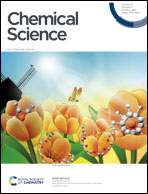Ligand-enforced intimacy between a gold cation and a carbenium ion: impact on stability and reactivity†
Abstract
Controlling the reactivity of transition metal complexes by positioning non-innocent functionalities around the catalytic pocket is a concept that has led to significant advances in catalysis. Here we describe our efforts toward the synthesis of dicationic phosphine gold complexes of general formula [(o-Ph2P(C6H4)Carb)Au(tht)]2+ decorated by a carbenium moiety (Carb) positioned in the immediate vicinity of the gold center. While the most acidic examples of such compounds have limited stability, the dicationic complexes with Carb+ = 9-N-methylacridinium and Carb+ = [C(ArN)2]+ (ArN = p-(C6H4)NMe2) are active as catalysts for the cycloisomerization of N-propargyl-4-fluorobenzamide, a substrate chosen to benchmark reactivity. The dicationic complex [(o-Ph2P(C6H4)C(ArN)2)Au(tht)]2+, which also promotes hydroarylation and enyne cyclization reactions, displays a higher catalytic activity than its acridinium analog, indicating that the electrophilic reactivity of these complexes scales with the Lewis acidity of the carbenium moiety. These results support the role of the carbenium unit as a non-innocent functionality which can readily enhance the activity of the adjacent metal center. Finally, we also describe our efforts toward the generation and isolation of free γ-cationic phosphines of general formula [(o-Ph2P(C6H4)Carb)]+. While cyclization into phosphonium species is observed for Carb+ = [C(ArN)2]+, [C(Ph)(ArN)]+, and 9-xanthylium, [(o-Ph2P(C6H4)-9-N-methylacridinium)]+ can be isolated as an air stable, biphilic derivative with uncompromised Lewis acidic and basic properties.



 Please wait while we load your content...
Please wait while we load your content...